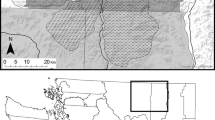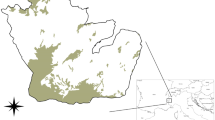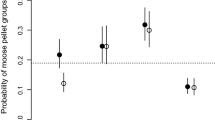Abstract
Predators use different spatial tactics to track the prey on the landscape. Three hypotheses describe spatial tactics: prey abundance for prey that are aggregated in space; prey habitat for uniformly distributed prey; and prey catchability for prey that are difficult to catch and kill. The gray wolf (Canis lupus) is a generalist predator that likely employs more than one spatial hunting tactic to match their diverse prey with distinct distributions and behavior that are available. We conducted a study on 17 GPS collared wolves in 6 packs in Riding Mountain National Park, Manitoba, Canada where wolves prey on moose (Alces alces) and elk (Cervus canadensis). We evaluated wolf selection for prey density, habitat selection and catchability on the landscape through within-territory habitat selection analysis. We reveal support for both the prey habitat and prey catchability hypotheses. For moose, their primary prey, wolves employed a mixed habitat and catchability tactic. Wolves used spaces described by the intersection of moose habitat and moose catchability. Wolves selected for the catchability of elk, their secondary prey, but not elk habitat. Counter to our predictions, wolves avoided areas of moose and elk density, likely highlighting the ongoing space race between predator and prey. We illustrate that of the three hypotheses the primary driver was prey catchability, where the interplay of both prey habitat with catchability culminate in predator spatial behaviour in a multiprey system.




Similar content being viewed by others

Availability of data
Input data for the wolf habitat selection analysis and metadata of raw locations is available online at https://github.com/CMProkopenko/wolfspace
Code availability
Code will be available at https://github.com/CMProkopenko/wolfspace.
References
Aarts G, Fieberg J, Matthiopoulos J (2012) Comparative interpretation of count, presence–absence and point methods for species distribution models. Methods Ecol Evol 3:177–187. https://doi.org/10.1111/j.2041-210X.2011.00141.x
Altmann M (1959) Group dynamics in wyoming moose during the rutting season. J Mammal 40:420–424
Andruskiw M, Fryxell JM, Thompson ID, Baker JA (2008) Habitat-mediated variation in predation risk by the American marten. Ecology 89:2273–2280. https://doi.org/10.1890/07-1428.1
Balme G, Hunter L, Slotow R (2007) Feeding habitat selection by hunting leopards Panthera pardus in a woodland savanna: prey catchability versus abundance. Anim Behav 74:589–598. https://doi.org/10.1016/j.anbehav.2006.12.014
Bates D, Mächler M, Bolker B, Walker S (2015) Fitting linear mixed-effects models using lme4. J Stat Softw 67:1–48. https://doi.org/10.18637/jss.v067.i01
van Beest FM, McLoughlin PD, Vander Wal E, Brook RK (2014) Density-dependent habitat selection and partitioning between two sympatric ungulates. Oecologia 175:1155–1165. https://doi.org/10.1007/s00442-014-2978-7
Bergman EJ, Garrott RA, Creel S et al (2006) Assessment of prey vulnerability through analysis of wolf movements and kill sites. Ecol Appl 16:273–284. https://doi.org/10.1890/04-1532
Bjørneraas K, Solberg EJ, Herfindal I et al (2011) Moose Alces alces habitat use at multiple temporal scales in a human-altered landscape. Wbio 17:44–54. https://doi.org/10.2981/10-073
Carbyn LN (1980) Ecology and management of wolves in Riding Mountain National Park, Manitoba. Canadian Wildlife Service
Carbyn LN (1983) Wolf predation on Elk in riding mountain national park Manitoba. J Wildl Manag 47:963. https://doi.org/10.2307/3808155
Castillo DF, Vidal EML, Casanave EB et al (2012) Habitat selection of Molina’s hog-nosed skunks in relation to prey abundance in the Pampas grassland of Argentina. J Mammal 93:716–721
Creel S, Winnie J Jr, Maxwell B et al (2005) Elk alter habitat selection as an antipredator response to wolves. Ecology 86:3387–3397. https://doi.org/10.1890/05-0032
Dale BW, Adams LG, Bowyer RT (1994) Functional response of wolves preying on barren-ground caribou in a multiple-prey ecosystem. J Anim Ecol 63:644–652
Davidson Z, Valeix M, Loveridge AJ et al (2012) Environmental determinants of habitat and kill site selection in a large carnivore: scale matters. J Mammal 93:677–685. https://doi.org/10.1644/10-MAMM-A-424.1
Dickie M, Serrouya R, Avgar T et al (2022) Resource exploitation efficiency collapses the home range of an apex predator. Ecology. https://doi.org/10.1002/ecy.3642
ESRI (2016) ArcGIS Desktop
Fagan WF, Lewis MA, Auger-Méthé M et al (2013) Spatial memory and animal movement. Ecol Lett 16:1316–1329. https://doi.org/10.1111/ele.12165
Fieberg J, Signer J, Smith B, Avgar T (2021) A ‘How to’ guide for interpreting parameters in habitat-selection analyses. J Anim Ecol 90:1027–1043. https://doi.org/10.1111/1365-2656.13441
Garrott RA, Bruggeman JE, Becker MS et al (2007) Evaluating prey switching in wolf-ungulate systems. Ecol Appl 17:1588–1597. https://doi.org/10.1890/06-1439.1
Hammond JI, Luttbeg B, Sih A (2007) Predator and prey space use: dragonflies and tadpoles in an interactive game. Ecology 88:1525–1535. https://doi.org/10.1890/06-1236
Hebblewhite M, Pletscher DH (2002) Effects of elk group size on predation by wolves. Can J Zool 80:10
Hebblewhite M, Merrill EH, McDonald TL (2005) Spatial decomposition of predation risk using resource selection functions: an example in a wolf–elk predator–prey system. Oikos 111:101–111. https://doi.org/10.1111/j.0030-1299.2005.13858.x
Hijmans RJ, van Etter J, Cheng J et al (2017) Geographic data analysis and modeling. R CRAN Proj 2:15
Holling CS (1959) The components of predation as revealed by a study of small- mammal predation of the European pine sawfly. Can Entomol. https://doi.org/10.4039/Ent91293-5
Holling CS (1966) The functional response of invertebrate predators to prey density. Mem Entomol Soc Can 98:5–86. https://doi.org/10.4039/entm9848fv
Hopcraft JGC, Sinclair ARE, Packer C (2005) Planning for success: serengeti lions seek prey accessibility rather than abundance. J Anim Ecol 74:559–566. https://doi.org/10.1111/j.1365-2656.2005.00955.x
Huggard DJ (1993) Prey selectivity of wolves in Banff National Park. II. age, sex, and condition of elk. Can J Zool 71:140–147. https://doi.org/10.1139/z93-020
Janson CH (1998) Experimental evidence for spatial memory in foraging wild capuchin monkeys, Cebus apella. Anim Behav 55:1229–1243. https://doi.org/10.1006/anbe.1997.0688
Johnson DH (1980) The comparison of usage and availability measurements for evaluating resource preference. Ecology 61:65–71. https://doi.org/10.2307/1937156
Johnson CJ, Parker KL, Heard DC, Gillingham MP (2002) A multiscale behavioral approach to understanding the movements of woodland caribou. Ecol Appl 12:1840–1860. https://doi.org/10.1890/1051-0761(2002)012[1840:AMBATU]2.0.CO;2
Jung TS, Chubbs TE, Jones CG et al (2009) Winter habitat associations of a low-density moose (Alces americanus) population in central Labrador. Nena 16:471–480. https://doi.org/10.1656/045.016.n313
Kittle AM, Fryxell JM, Desy GE, Hamr J (2008) The scale-dependent impact of wolf predation risk on resource selection by three sympatric ungulates. Oecologia 157:163–175
Kittle AM, Anderson M, Avgar T et al (2017) Landscape-level wolf space use is correlated with prey abundance, ease of mobility, and the distribution of prey habitat. Ecosphere 8:e01783. https://doi.org/10.1002/ecs2.1783
Latham ADM, Latham MC, Knopff KH et al (2013) Wolves, white-tailed deer, and beaver: implications of seasonal prey switching for woodland caribou declines. Ecography 36:1276–1290. https://doi.org/10.1111/j.1600-0587.2013.00035.x
Lesmerises F, Dussault C, St-Laurent M-H (2012) Wolf habitat selection is shaped by human activities in a highly managed boreal forest. For Ecol Manage 276:125–131. https://doi.org/10.1016/j.foreco.2012.03.025
Lüdecke D (2018) ggeffects: tidy data frames of marginal effects from regression models. J Open Source Softw 3:1–5. https://doi.org/10.21105/joss.00772
Manitoba Remote Sensing Centre (2004) Land use and land cover mapping of Manitoba. Winnipeg, Manitoba
Manly BF, McDonald L, Thomas DL et al (2007) Resource selection by animals: statistical design and analysis for field studies. Springer Science & Business Media, Berlin
Mao JS, Boyce MS, Smith DW et al (2005) Habitat selection by elk before and after wolf reintroduction in Yellowstone National Park. Wild 69:1691–1707. https://doi.org/10.2193/0022-541X(2005)69[1691:HSBEBA]2.0.CO;2
Mech LD, Boitani L (2003) Wolves behavior, ecology, and conservation. The University of Chicago Press, Chicago
Messier F, Barrette C (1985) The efficiency of yarding behaviour by white-tailed deer as an antipredator strategy. Can J Zool 63:785–789. https://doi.org/10.1139/z85-115
Metz MC, Smith DW, Vucetich JA et al (2012) Seasonal patterns of predation for gray wolves in the multi-prey system of Yellowstone National Park. J Anim Ecol 81:553–563. https://doi.org/10.1111/j.1365-2656.2011.01945.x
Mitchell WA, Lima SL (2002) Predator-prey shell games: large-scale movement and its implications for decision-making by prey. Oikos 99:249–259. https://doi.org/10.1034/j.1600-0706.2002.990205.x
Mukherjee S, Heithaus MR (2013) Dangerous prey and daring predators: a review. Biol Rev 88:550–563. https://doi.org/10.1111/brv.12014
Northrup J, Vander Wal E, Bonar M et al (2021) Conceptual and methodological advances in habitat-selection modeling: guidelines for ecology and evolution. Ecol Appl 32:e02470. https://doi.org/10.1002/eap.2470
Paquet PC (1992) Prey use strategies of sympatric wolves and coyotes in riding mountain national park, Manitoba. J Mammal 73:337–343
Patterson BR, Messier FO (2001) Social organization and space use of coyotes in Eastern Canada relative to prey distribution and abundance. J Mammal 82:15
Petrunenko YK, Montgomery RA, Seryodkin IV et al (2016) Spatial variation in the density and vulnerability of preferred prey in the landscape shape patterns of Amur tiger habitat use. Oikos 125:66–75. https://doi.org/10.1111/oik.01803
Prokopenko CM, Boyce MS, Avgar T (2017) Extent-dependent habitat selection in a migratory large herbivore: road avoidance across scales. Landsc Ecol 32:313–325. https://doi.org/10.1007/s10980-016-0451-1
R. Heithaus M, M. Dill L, (2006) Does tiger shark predation risk influence foraging habitat use by bottlenose dolphins at multiple spatial scales? Oikos 114:257–264. https://doi.org/10.1111/j.2006.0030-1299.14443.x
Rachlow JL, Bowyer RT (1998) Habitat selection by Dall’s sheep (Ovis dalli): maternal trade-offs. J Zool 245:457–465. https://doi.org/10.1111/j.1469-7998.1998.tb00120.x
Regular PM, Hedd A, Montevecchi WA (2013) Must marine predators always follow scaling laws? Memory guides the foraging decisions of a pursuit-diving seabird. Anim Behav 86:545–552. https://doi.org/10.1016/j.anbehav.2013.06.008
Renner IW, Elith J, Baddeley A et al (2015) Point process models for presence-only analysis. Methods Ecol Evol 6:366–379. https://doi.org/10.1111/2041-210X.12352
Roberts DR, Bahn V, Ciuti S et al (2017) Cross-validation strategies for data with temporal, spatial, hierarchical, or phylogenetic structure. Ecography 40:913–929. https://doi.org/10.1111/ecog.02881
Rodgers AR, Carr AP (2015) HRT: Home Range Tools for ArcGIS. http://www.jennessent.com/arcgis/HRT/index.html. Accessed 8 Feb 2022
Rose GA, Leggett WC (1990) The Importance of scale to predator-prey spatial correlations: an example of Atlantic fishes. Ecology 71:33–43
Sallows TA (2007) Diet preference and parasites of grey wolves in riding mountain National Park of Canada. University of Manitoba, Winnipeg
Sallows T (2016) Riding Mountain elk/moose classified count survey and minimum population counts 2016. Parks Canada, Manitoba
Sallows T, Baird R, Frey S (2017) Riding mountain national park wolf survey results. Parks Canada, Manitoba
Sand H, Eklund A, Zimmermann B et al (2016) Prey selection of scandinavian wolves: single large or several small? PLoS ONE 11:e0168062. https://doi.org/10.1371/journal.pone.0168062
Schneider D, Piatt J (1986) Scale-dependent correlation of seabirds with schooling fish in a coastal ecosystem. Mar Ecol Prog Ser 32:237–246. https://doi.org/10.3354/meps032237
Sih A (2005) Predator-prey space use as an emergent outcome of a behavioral response race. Ecol Predator-Prey Interact 240–255
Sillero-Zubiri C, Gottelli D (1995) Diet and feeding behavior of Ethiopian wolves (Canis simensis). J Mammal 76:531–541
Stein RA, Magnuson JJ (1976) Behavioral response of crayfish to a fish predator. Ecology 57:751–761
Street GM, Vander Vennen LM, Avgar T et al (2015) Habitat selection following recent disturbance: model transferability with implications for management and conservation of moose (Alces alces). Can J Zool 93:813–821. https://doi.org/10.1139/cjz-2015-0005
Stronen AV, Forbes GJ, Paquet PC et al (2012) Dispersal in a plain landscape: short-distance genetic differentiation in southwestern Manitoba wolves, Canada. Conserv Genet 13:359–371. https://doi.org/10.1007/s10592-011-0290-1
Tallian A, Smith DW, Stahler DR et al (2017) Predator foraging response to a resurgent dangerous prey. Funct Ecol 31:1418–1429. https://doi.org/10.1111/1365-2435.12866
Thaker M, Vanak AT, Owen CR et al (2011) Minimizing predation risk in a landscape of multiple predators: effects on the spatial distribution of African ungulates. Ecology 92:398–407. https://doi.org/10.1890/10-0126.1
Valeix M, Loveridge AJ, Macdonald DW (2012) Influence of prey dispersion on territory and group size of African lions: a test of the resource dispersion hypothesis. Ecology 93:2490–2496. https://doi.org/10.1890/12-0018.1
Vander Wal E, McLoughlin PD, Brook RK (2011) Spatial and temporal factors influencing sightability of elk. J Wildl Manag 75:1521–1526. https://doi.org/10.1002/jwmg.208
Vander Wal E, van Beest FM, Brook RK (2013) Density-dependent effects on group size are sex-specific in a gregarious ungulate. PLoS ONE 8:1–9
Warren M (2008) GPS-data clustering software
Warton DI, Shepherd LC (2010) Poisson point process models solve the “pseudo-absence problem” for presence-only data in ecology. Ann Appl Stat 4:1383–1402
Webb NF, Hebblewhite M, Merrill EH (2008) Statistical methods for identifying wolf kill sites using global positioning system locations. J Wildl Manag 72:798–807. https://doi.org/10.2193/2006-566
Weckel M, Giuliano W, Silver S (2006) Jaguar (Panthera onca) feeding ecology: distribution of predator and prey through time and space. J Zool 270:25–30. https://doi.org/10.1111/j.1469-7998.2006.00106.x
Wikenros C, Sand H, Wabakken P et al (2009) Wolf predation on moose and roe deer: chase distances and outcome of encounters. Acta Theriol 54:207–218. https://doi.org/10.4098/j.at.0001-7051.082.2008
Williams AC, Flaxman SM (2012) Can predators assess the quality of their prey’s resource? Anim Behav 83:883–890. https://doi.org/10.1016/j.anbehav.2012.01.008
Zimmermann B, Sand H, Wabakken P et al (2015) Predator-dependent functional response in wolves: from food limitation to surplus killing. J Anim Ecol 84:102–112. https://doi.org/10.1111/1365-2656.12280
Acknowledgements
We would like to thank A. Critchley and R. Sandstrom from Shoal Lake Aviation and T. Sallows, D. Bergeson, K. Kingdon, R. Robinson, R. Baird, R. Grzela and many more Parks Canada staff for their contributions to fieldwork. V. Harriman, Y. Wiersma, P. Paquet, K.A. Kingdon, D. Dupont, and members of the Wildlife Evolutionary Ecology Lab provided valuable comments on the study. We would like to thank three anonymous reviewers for their thoughtful comments that greatly improved our work.
Funding
This work was made possible through the support of Parks Canada, Manitoba Fish and Wildlife Fund, the Nature Conservancy of Canada, and the Natural Sciences and Engineering Research Council of Canada. CMP was awarded a Vanier Graduate Scholarship and EVW was awarded an NSERC Discovery Grant.
Author information
Authors and Affiliations
Contributions
SZS and CMP formulated the idea, conducted fieldwork, and designed the analysis. SZS conducted the analysis. SZS and CMP wrote the manuscript. EVW provided conceptual and editorial advice.
Corresponding author
Ethics declarations
Conflict of interest
Not applicable.
Ethics approval
All applicable institutional and national guidelines for the care and use of animals were followed (Memorial University AUP 16-02-EV).
Consent to participate
Not applicable.
Consent for publication
Not applicable.
Additional information
Communicated by Anders Angerbjörn.
The study occurred within a novel ecological event: wolves switched from primarily feeding on elk to moose. Our results illustrate the spatial trade-ofs that predators resolve in multiprey.
Supplementary Information
Below is the link to the electronic supplementary material.
Rights and permissions
Springer Nature or its licensor holds exclusive rights to this article under a publishing agreement with the author(s) or other rightsholder(s); author self-archiving of the accepted manuscript version of this article is solely governed by the terms of such publishing agreement and applicable law.
About this article
Cite this article
Zabihi-Seissan, S., Prokopenko, C.M. & Vander Wal, E. Wolf spatial behavior promotes encounters and kills of abundant prey. Oecologia 200, 11–22 (2022). https://doi.org/10.1007/s00442-022-05218-4
Received:
Accepted:
Published:
Issue Date:
DOI: https://doi.org/10.1007/s00442-022-05218-4



